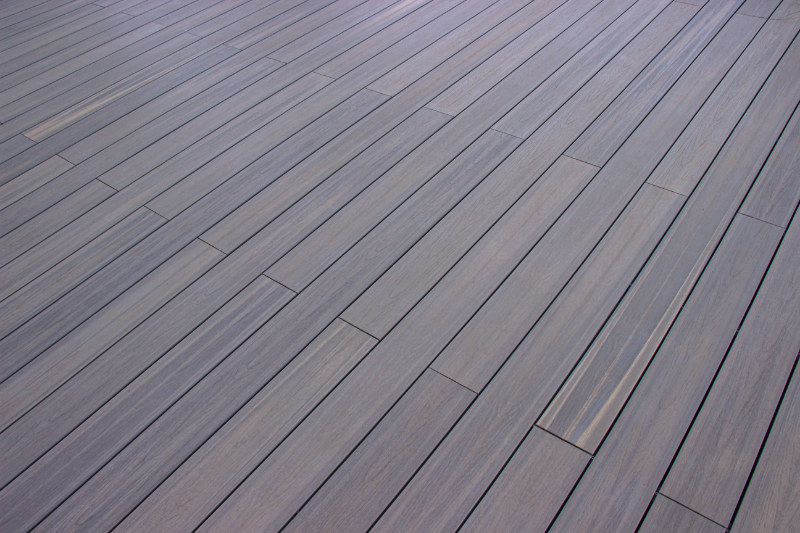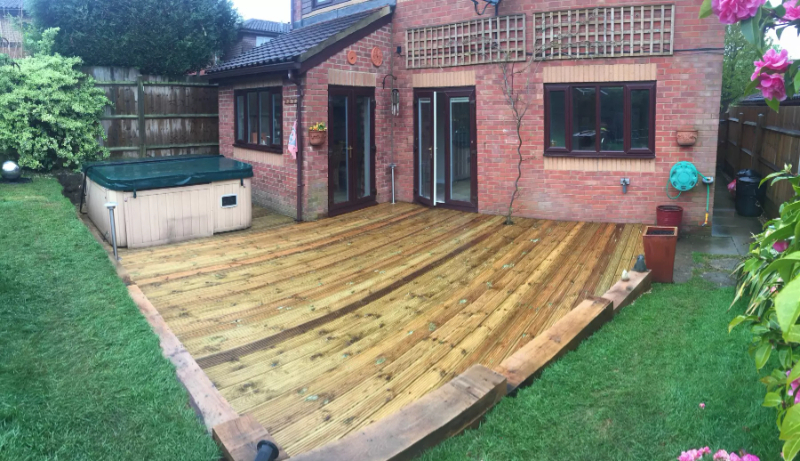A well kept deck is a joy to use. With the right cleaning, care and treatment, your decking will stay in good condition for years, so you can enjoy your garden in spring, summer and through winter. The aim is simple. Remove dirt and debris, protect the wood from moisture and sun, and repair small issues before they turn into damage that is costly to fix.
Decking Basics
Start by checking what you have. Timber decking needs regular upkeep because wood moves with weather and time. The grain will open and close as moisture levels change, which can lead to stains, mould and rot if the surface is left wet.
Composite decking is more resistant to wear, stains and algae, although it still needs cleaning to keep it looking its best. Choose products designed for the material you have, and always read the label for information on use.
With steady maintenance, timber decking can last ten to fifteen years or more. Cleaned and treated boards resist rain and sun, so they keep their strength and appearance for longer. Composite decking often lasts twenty to thirty years, as it is designed to be resistant to moisture and wear. Whatever material you choose, a little care each week and a planned treatment each year will protect the surface for the long term.
Cleaning & Regular Care
Dirt, leaves and grime hold water against the surface. This speeds up wear and can make boards slippery and risky to walk on. A soft broom is the first tool to use. Sweep away debris every week in wet months and at least every fortnight in summer. For a deeper wash, use a decking cleaner mixed in the correct order with water. Scrubbing with a stiff brush lifts algae and mould from the grain.
Rinse well so no product is left behind. If you use a pressure washer, keep the lance moving and use a low-pressure fan setting to avoid warping fibres or stripping colour.
A pressure washer is useful when used with care. Keep the nozzle at least 30 centimetres from the surface, choose a wide fan, and use low pressure. Work with the grain and keep moving so you do not cut the timber. Finish with a light rinse to clear residues. Allow the deck to dry fully, then apply oil or stain as required.
Algae makes a surface look green and can turn steps slippery. Use a cleaner designed for decking, scrub, then rinse. Treat stubborn mould spots with a product that states it is safe for timber.
Act fast on food and grease. Barbecue spills and cooking oil can leave dark stains if left in place. Use a degreasing cleaner and warm water, then rinse well. For tannin marks and rust from furniture, a light oxalic-based cleaner may help, but always test a small patch first.
A clean, dry surface is the best defence. Keep paths and steps free of grime and algae, and place mats at doors so less dirt reaches the deck. If an area is shaded and stays damp, plan for extra scrubbing in those months. Some anti-slip coatings exist, but they still require regular cleaning to stay effective.
Do not apply treatment to damp timber, because the product will not soak in and may peel. Do not leave planters and firewood in one place for months, because trapped moisture can stain and cause rot. Do not use bleach on wood unless the label states it is safe, because it can damage fibres and lighten colour unevenly. Always rinse after cleaning and allow full drying time before applying oil, stain or paint.

Seasonal & Environmental Maintenance
Decking needs change with the seasons. In spring, clean away winter dirt and check for raised screws, loose fixings and early signs of rot. In summer, wash off barbecue grease quickly and move furniture around so the sun does not leave uneven colour.
In autumn, sweep often to keep wet leaves off the boards. In winter, keep the surface clear and dry where possible. Ice-melt products that contain rock salt can mark timber, so use sparingly and rinse when the weather improves.
Water is the main cause of long-term problems. Make sure gaps between boards are clear so rain can drain through. Check the ground under the deck. Good airflow underneath helps the surface dry faster, which reduces mould growth and rot.
Trim nearby plants so they do not touch the boards, because leaves that sit on the surface trap moisture and lead to slippery patches.
Sunlight fades timber over time. If you like the weathered silver look, keep the surface clean and treat for moisture only. If you want to keep colour, use a UV-resistant stain or oil. Make sure you apply thin, even coats and follow the recommended drying time. Moving planters and mats each month helps avoid patchy colour and trapped moisture under heavy items.
Cold weather brings extra challenges. Do not chip ice with metal tools, because this can gouge the surface. Use a plastic shovel and brush instead. Store soft furnishings so they are dry, and lift outdoor rugs so water does not sit on the boards. If your area sees a lot of rain, consider a clear sealant before winter so water runs off and the surface dries faster.
Treatments & Repairs
Treating timber is essential. A decking oil soaks into the wood and protects the grain from moisture. It keeps a natural look and is easy to refresh. A decking stain adds colour and includes protection from sun fade and rain. Paint creates a strong colour layer but may show wear in high-traffic areas. Whatever you choose, the surface must be clean and dry.
Apply thin coats with a good-quality brush, work along the grain, and allow full drying time between coats. A water-drop test helps you decide when to recoat. If water soaks in, apply treatment soon. If it beads on the surface, protection is still active.
Preparation gives better results than any product alone. Wash the deck, let it dry, then sand rough or splintered areas so the surface is smooth underfoot. Sanding also helps new coating grip. Vacuum or brush away dust so nothing is left on the boards.
Mask around walls and doors to keep clean edges. Treat cut ends with end-grain preservative, because these areas absorb a lot of moisture and require extra care.
Set time aside each year to check every board. Look for cracks, warping and soft patches. Replace damaged boards quickly so problems do not spread. Tighten loose screws and change any fixings that have lifted.
Protruding heads are a trip risk and can catch on shoes or pets. Where boards meet the house, check the flashing and the connection so water cannot get behind the frame.
Composite decking is durable and low maintenance, but it still benefits from regular cleaning. Wash with warm water and a mild cleaner, scrub lightly, then rinse. Most grease marks can be removed if you act quickly. Avoid solvent products not recommended by the manufacturer. Composite boards do not need oil or stain, so follow the maker’s advice and keep the surface clear of debris.
Quick FAQs In Plain English
How often should I clean the deck? Light sweeping weekly, a wash each month in wet weather, and a deep clean once a year is a good rule.
When should I recoat? Check with a water-drop test every six months, then reapply oil or stain when water no longer beads.
Can I pressure wash every time? Use it sparingly and with low pressure, and rely on scrubbing for most cleans.
If you need further advice on cleaning and maintaining your decking, or you're interested in getting a decking replacement, then get in touch today. Our decking professionals can assist you during this decision.


